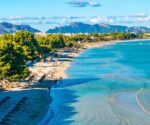Spain’s smallest island crumbling into the sea as locals escape holidaymakers | Travel News | Travel
Every day, thousands of tourists flock to a tiny Spanish island that is struggling to prevent the few buildings it has from crumbling into the sea. If you’re just visiting, it is easy to miss it, which has also made it popular with locals.
Despite being just a few kilometres off the coast of Alicante and technically part of the Spanish resort, which has long been a favourite with British holidaymakers, the island of Nueva Tabarca is almost deserted.
At 1,800m long and 400m wide, and home to just 68 permanent residents, Tabarca is Spain’s smallest inhabited island. It also boasts a colourful history, as the possible landing spot of St. Paul and a former haven for pirates.
In recent years, more and more people have been taking the Ferry Azul boats from the mainland, delighting in the shoals of small fish that gather around its glass sides during the journey. But, unlike in other parts of Spain, it is not the tourists causing the tiny island’s problems.
Upon arrival, they are often struck by the same realisation. “It’s a lot smaller than I thought. When they said it was a small island…it’s like, tiny,” remarked Sante, who recently visited Tabarca with his wife.
This becomes a significant issue as up to 5,000 people descend on Tabarca each day during peak season, increasing the full-time population by 30 times.
From 10 am to 9 pm, the island’s lone primary thoroughfare is thronged with guests, though their stay is typically short-lived as evening approaches.
Carmen Martí, the head of the local neighbourhood association, maintains that “the problem isn’t tourists,” the Mirror reports. She explained that underlying infrastructural challenges pose a much greater concern.
She recounted her frustration with the facilities, or lack thereof: “There are no public restrooms, no shaded areas, tourist attractions, such as the church or the vaults of the wall, are closed, the tower is in ruins.”
The island’s medical facilities are scant, and risks are present due to the absence of lifeguards for much of the year and Tabarca’s reputation for blistering heat. With its elevation barely 15 meters above sea level and a scarcity of trees, there’s little respite from the relentless sun.
Carmen said that despite locals urging authorities to enhance the island’s conditions, their efforts have been largely overlooked. “We’ve presented plans for a rest area to the town hall so that young people don’t have to eat and rest sitting on the town’s sidewalks, but they’ve ignored it.”
The root of these problems lies partly in the island’s governance, split between two administrations, leading to long-standing vacancies in several roles. This situation, along with its isolated location, results in the island being neglected, according to residents.
Locals report that municipal buildings, including offices, warehouses, and even a museum less than two decades old, are in a dire state. The corrosive effects of salt have damaged roofs and forced the closure of the museum as a safety measure.
Despite these challenges, including the aggressive seagulls known to attack beachgoers, visitors continue to flock here. They are drawn by the stunning beaches and crystal-clear waters, safeguarded by Spain’s inaugural marine reserve, established in 1986.








